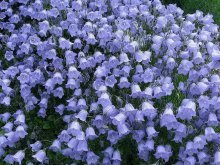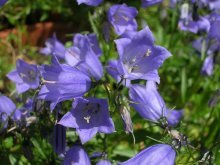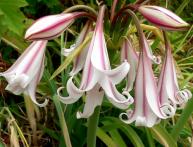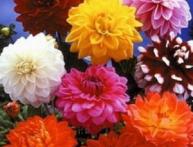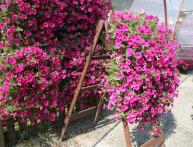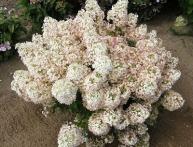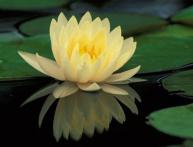Spoonbell-leaved bell: features, care and cultivation
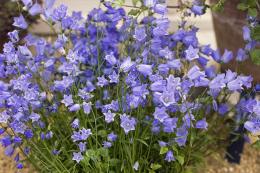
In those areas that are well illuminated by the sun, gardeners often plant bellflower. With its help you can decorate borders, roads, flower beds. The huge advantage of this plant is that they bloom throughout the summer, so they give a fabulous look for a long period. With their help you can complement alpine slides and other parts summer cottage. What are the features of a flower? How to grow it?
Content:
- Description of the species
- What are the advantages and features of Bellflower?
- Features of cultivation
- Benefits and applications in cooking, folk medicine
Description of the species
All bells belong to the genus Campanula. Their family is considered to be bellflowers. They are a biennial plant that tolerates frost easily. Their stems stand straight. The bellflower is especially valued for its flowering.
Its flowers have amazing beauty, which are collected in inflorescences. Since ancient times bell People fell in love with it, which is why they gave it such a tender name. In other areas it is called differently, for example, bells, chenilles.
What are the advantages and features of Bellflower?
The bell-leaved plant has an elegant appearance. The plant does not grow large. It stretches up to 13 cm in height.The flowers are also miniature in size and painted in snow-white or heavenly colors. Their diameter reaches 10 mm. In nature, such a flower is found in the mountainous areas of Europe. Its stems are thread-like. It forms a whole carpet. The foliage is not large in size and is colored light green.
Flowering occurs throughout the summer. This plant is capable of self-seeding an area. Until late autumn the bell will look decoratively, decorating a summer cottage. But it is worth remembering that it is capable of growing well, drowning out other weak plants.
Features of cultivation
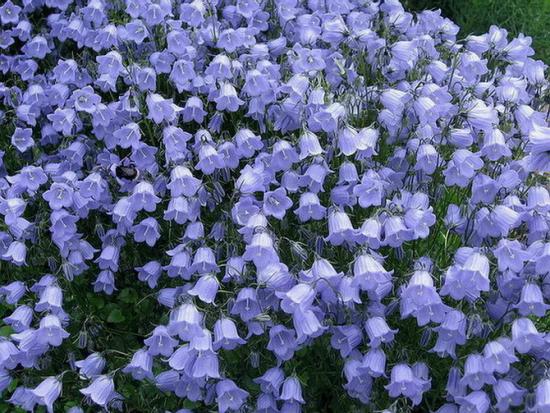
This plant does not require special care. But it is desirable that the soil is drained and slightly alkaline. The bell does not react well to stagnant moisture, so experienced gardeners build drainage ditches. You should not grow the plant in areas that are flooded with rain in the spring.
It is recommended to adhere to the following planting and care rules:
- The soil is dug up, going 40 cm deep. Weeds must be carefully removed.
- If the soil contains clay, then it is worth adding sand or peat to it. The result will be sufficiently nutritious soil, so you don’t have to fertilize it.
- It is recommended to add turf soil and humus to sandy soils.
- You should not add fresh manure or peat to the soil, as they may contain fungi.
- Spoonbell-leaved bellflower grows well in acidic soils.
- In spring, it is recommended to add nitrogen fertilizers to the soil. It is also worth pouring ash and manure near the bushes.
- When buds begin to form, it is worth adding a mineral mixture to the soil.
- Before the plant blooms, it is necessary to weed and loosen priming.
- Bluebells often do not need to be watered. If the summer is too hot, then it is worthwhile to water moderately.
- To ensure flowering lasts longer, experienced gardeners advise promptly eliminating flowers that have dried out or are already fading.
- To collect seeds, shoots with capsules are left. It is worth cutting them off in time. This is done when the boxes turn brown. They may burst later.
- At the end of September, it is necessary to cut off all the stems near the root.
Transplantation is carried out in autumn or spring. The bellflower has a weak root system, so it is recommended to replant it in May, when the soil warms up well. Autumn replanting is done in early autumn. The plant should take root before the first frosts appear.
By the way, there are also types of bells that are not prohibited from being replanted throughout the growing season, even during flowering.
When the plant is dug up, it is necessary to grab a lump of soil. A hole is made in a new location, which is watered before and after the transplant procedure. Reproduction bell planting is carried out using seeds, root segments, dividing the bush, and cuttings. Each gardener chooses the method that suits him. This plant rarely suffers from diseases. But if you grow it in one place, then microorganisms collect in the ground that can harm the bell, causing it to die.

To protect the plant from fungal diseases, it is necessary to treat it with a foundationazole solution in the spring and autumn. If the weather is damp for a long period, then the bell may be attacked by slugs.To destroy them, it is recommended to use superphosphate.
Benefits and applications in cooking, folk medicine
Bellflower inflorescences contain pollen and nectar. Therefore, they are excellent honey plants. Such plants are often planted near apiaries. In addition, it has found its use in cooking. Many people harvest bluebell foliage and add it to spring salads.
The plant contains biological active substances. Therefore, it is used to make drugs. They soothe and eliminate cough. Decoctions are prepared from this plant. They have healing properties. They are used when a sore throat occurs. Tinctures from bells are also prepared. After this, they are used as compresses to help with rheumatism. Such infusions can help with fresh wounds.
So, bellflower is a beautiful plant with which you can decorate your summer cottage. In addition, knowing the recipes of traditional medicine, it can be used to treat some ailments.
Video about growing bellflower:

